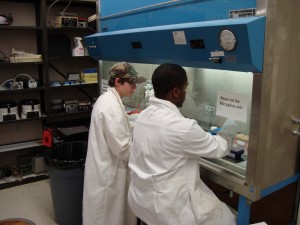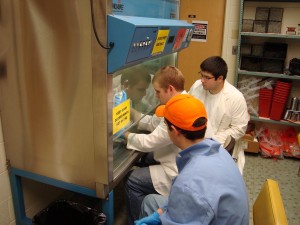It’s that time of the year when most people want to avoid the flu. Well not the case for H-SC Virology students!!!! This semester students in Dr. Kristian Hargadon’s Virology class are employing cutting edge molecular genetic techniques to reconstruct an influenza virus strain that first struck Puerto Rico in 1934! Viruses are quite simple in structure, consisting of a core of genetic material surrounded by a protective protein coat (and in the case of influenza, an additional lipid envelope). Because viruses are so simple, they cannot replicate on their own and instead must infect a cell before they can be copied and spread to other cells. The virus achieves this by releasing its genome into a cell and using the cell as a factory to produce more virus copies. Therefore, if one were to put an influenza genome into a cell, theoretically the cell could “build” the actual virus on its own. Because the entire genome of the 1934 Puerto Rico influenza virus has been sequenced, this is exactly what H-SC students are doing. Provided with plasmids encoding the influenza genome at the beginning of the semester, students are using an approach known as reverse genetics to construct the 1934 Puerto Rico influenza virus by forcing these plasmids into cell lines they are growing in culture. Once they are done, these students will learn and employ a number of techniques commonly used in virology laboratories to measure how much influenza virus was made! This approach for generating influenza virus has been a remarkable breakthrough in molecular virology and has enabled scientists around the world to construct recombinant influenza strains in order to understand the role that unique influenza gene products play in infection and viral pathogenicity!


